Scapula
Template:Infobox Bone Editor-In-Chief: C. Michael Gibson, M.S., M.D. [1]
Associate Editor-In-Chief: Cafer Zorkun, M.D., Ph.D. [2]
In anatomy, the scapula, or shoulder blade, is the bone that connects the humerus (arm bone) with the clavicle (collar bone).
The scapula forms the posterior part of the shoulder girdle. In humans, it is a flat bone, roughly triangular in shape.
Features
It has two surfaces, three borders, and three angles.
The anterior (front) side of the scapula shows the fossa subscapularis (subscapular fossa) to which the subscapularis muscle attaches.
The posterior surface of the scapula is divided by a bony projection, the spina scapulae (opposite to the fossa subscapularis) into the supraspinous fossa and the infraspinous fossa. This projection is called the spine of the scapula. It begins flat at the base of the shoulder bone, ascends in distal direction to its peak at about the middle of the scapula, this peak is called tuber scapulae. After this peak the spina scapulae steeply decays in height. For humans and carnivores and bovinae the spina runs into a forward pointing hook called acromion, which continues past the main part of the bone.
Another hook-like projection comes off the lateral angle of the scapula, and is called the coracoid process. The end of this hook is the site of attachment of many muscles, such as the coracobrachialis muscle.
Near the base of the coracoid process, so also on the lateral angle, there is a depression called the glenoid cavity. This forms the socket that the head of the humerus articulates with.
The scapula also articulates with the clavicle, via the acromion process (the acromioclavicular joint).
Muscles
The following muscles attach to the scapula:
| Muscle | Direction | Region |
| Pectoralis Minor | insertion | coracoid process |
| Coracobrachialis | origin | coracoid process |
| Serratus Anterior | insertion | medial border |
| Triceps Brachii (long head) | origin | infraglenoid tubercle |
| Biceps Brachii(short head) | origin | coracoid process |
| Subscapularis | origin | subscapular fossa |
| Rhomboid Major | insertion | medial border |
| Rhomboid Minor | insertion | medial border |
| Levator Scapulae | insertion | medial border |
| Trapezius | insertion | spine of scapula |
| Deltoid | origin | spine of scapula |
| Supraspinatus | origin | supraspinous fossa |
| Infraspinatus | origin | infraspinous fossa |
| Teres Minor | origin | lateral border |
| Teres Major | origin | lateral border |
| Latissimus Dorsi (a few fibers) | origin | inferior angle |
| Omohyoid | origin | superior border |
Surfaces
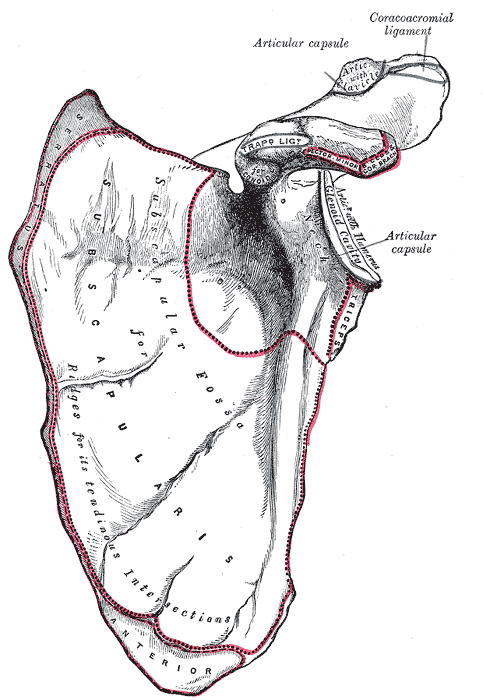 | | 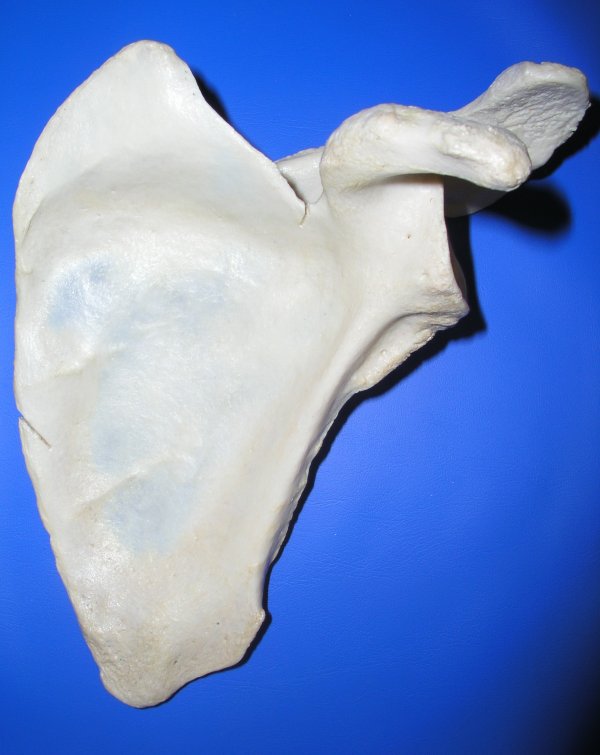
|
| Figure 1 : Left scapula. Costal surface. |
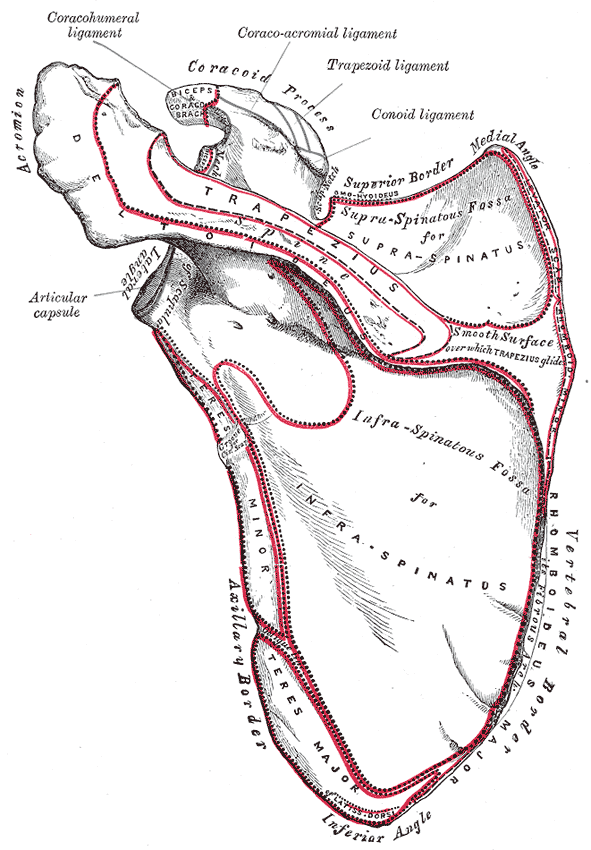 | | 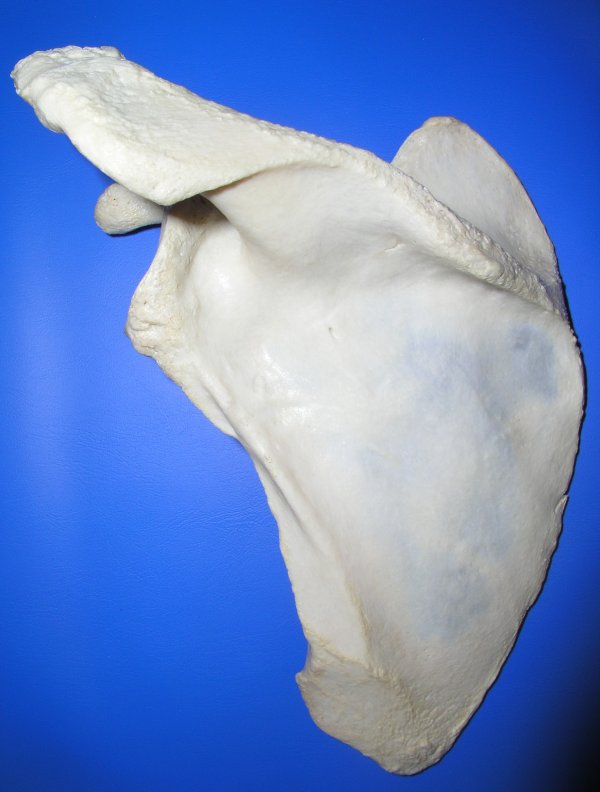
|
| Figure 2 : Left scapula. Dorsal surface. |
Costal
The costal or ventral surface [Fig. 1] presents a broad concavity, the subscapular fossa.
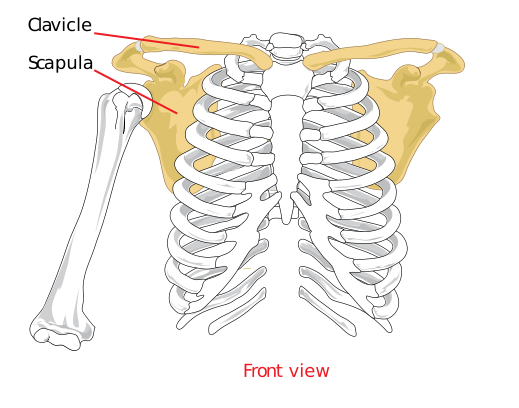
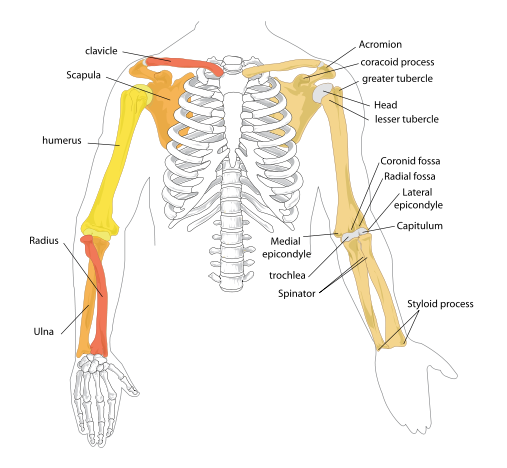
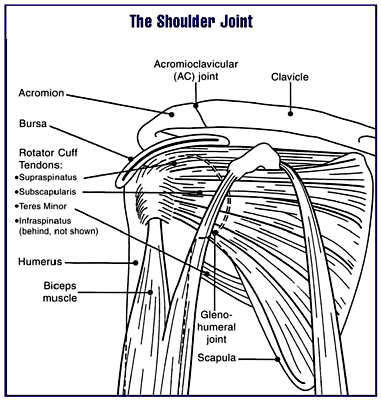

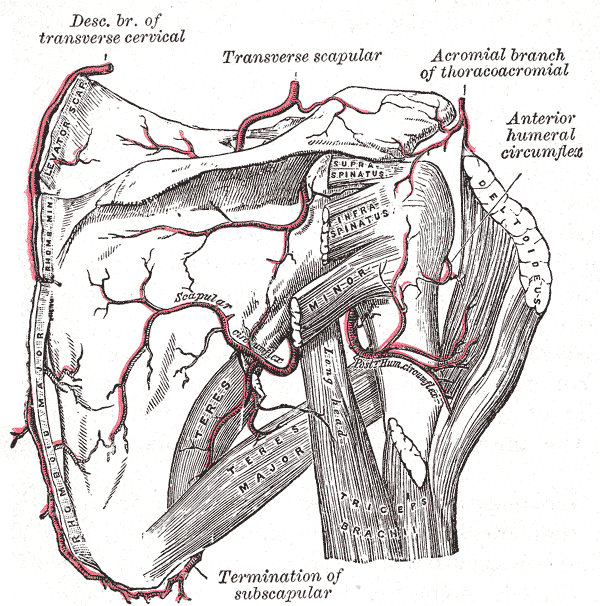
The medial two-thirds of this fossa are marked by several oblique ridges, which run lateralward and upward. The ridges give attachment to the tendinous insertions, and the surfaces between them to the fleshy fibers, of the Subscapularis. The lateral third of the fossa is smooth and covered by the fibers of this muscle.
The subscapular fossa is separated from the vertebral border by smooth triangular areas at the medial and inferior angles, and in the interval between these by a narrow ridge which is often deficient. These triangular areas and the intervening ridge afford attachment to the Serratus anterior.
At the upper part of the fossa is a transverse depression, where the bone appears to be bent on itself along a line at right angles to and passing through the center of the glenoid cavity, forming a considerable angle, called the subscapular angle; this gives greater strength to the body of the bone by its arched form, while the summit of the arch serves to support the spine and acromion.
Dorsal
The dorsal surface [Fig. 2] is arched from above downward, and is subdivided into two unequal parts by the spine; the portion above the spine is called the supraspinatous fossa, and that below it the infraspinous fossa.
- The supraspinous fossa, the smaller of the two, is concave, smooth, and broader at its vertebral than at its humeral end; its medial two-thirds give origin to the Supraspinatus.
- The infraspinous fossa is much larger than the preceding; toward its vertebral margin a shallow concavity is seen at its upper part; its center presents a prominent convexity, while near the axillary border is a deep groove which runs from the upper toward the lower part. The medial two-thirds of the fossa give origin to the Infraspinatus; the lateral third is covered by this muscle.
The dorsal surface is marked near the axillary border by an elevated ridge, which runs from the lower part of the glenoid cavity, downward and backward to the vertebral border, about 2.5 cm above the inferior angle.
The ridge serves for the attachment of a fibrous septum, which separates the Infraspinatus from the Teres major and Teres minor.
The surface between the ridge and the axillary border is narrow in the upper two-thirds of its extent, and is crossed near its center by a groove for the passage of the scapular circumflex vessels; it affords attachment to the Teres minor.
Its lower third presents a broader, somewhat triangular surface, which gives origin to the Teres major, and over which the Latissimus dorsi glides; frequently the latter muscle takes origin by a few fibers from this part.
The broad and narrow portions above alluded to are separated by an oblique line, which runs from the axillary border, downward and backward, to meet the elevated ridge: to it is attached a fibrous septum which separates the Teres muscles from each other.
The Acromion
The acromion forms the summit of the shoulder, and is a large, somewhat triangular or oblong process, flattened from behind forward, projecting at first lateralward, and then curving forward and upward, so as to overhang the glenoid cavity.
Borders
There are three borders of the scapula:
- The superior border is the shortest and thinnest; it is concave, and extends from the medial angle to the base of the coracoid process.
- The axillary border (or "lateral border") is the thickest of the three. It begins above at the lower margin of the glenoid cavity, and inclines obliquely downward and backward to the inferior angle.
- The vertebral border (or "medial border") is the longest of the three, and extends from the medial to the inferior angle.
Angles
There are three angles:
- The medial angle (or "superior angle")
- The inferior angle
- The lateral angle
Structure
The head, processes, and the thickened parts of the bone, contain cancellous tissue; the rest consists of a thin layer of compact tissue.
The central part of the supraspinatous fossa and the upper part of the infraspinatous fossa, but especially the former, are usually so thin as to be semitransparent; occasionally the bone is found wanting in this situation, and the adjacent muscles are separated only by fibrous tissue.
Movements
Movements of the scapula are brought about by scapular muscles:
Elevation, Depression, Protraction, Retraction, Lateral rotation, (Medial rotation)
External links
- Template:SUNYAnatomyLabs - "Joints of the Upper Extremity: Scapula
Sources
Additions have been made from "Nickel; Schummer; Seiferle; Lehrbuch der Anatomie der Haussäugetiere.
See also
| Wikimedia Commons has media related to Scapula. |
Template:Bones of upper extremity
ar:لوح الكتف
ca:Omòplat
de:Scapula
eo:Skapolo
gl:Omoplata
id:Tulang belikat
it:Scapola
he:עצם השכם
la:Scapula
lt:Mentė
hu:Lapocka
nl:Schouderblad
new:स्क्यापुला
sk:Lopatka
fi:Lapaluu
sv:Skulderblad
th:กระดูกสะบัก
uk:Лопатка